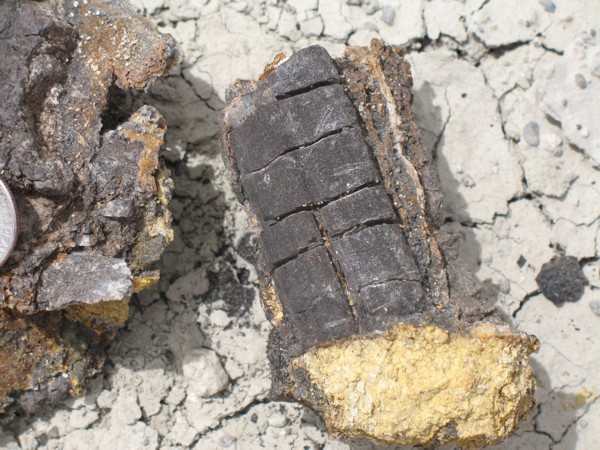An Update on the Forest Fires at Ghost Ranch
 (Ghost Ranch, New Mexico: The find was located in the center valley between the two peaks shown here)
(Ghost Ranch, New Mexico: The find was located in the center valley between the two peaks shown here)I've been meaning to do this for a while now. Back in May, I posted a brief description of a find we made while in New Mexico. At the time, I did not have photos to post along with the description. So, here's a brief re-cap and a few photos of the region.
Young earth creationists are very fond of the flood story of Noah. They are; however, loathe to fully describe the strata that were laid down, pre, post and syn flood. There is a reason that they shy away from describing the flood strata. If they point vaguely at some rocks and say 'fossils in the rocks are of animals killed in the flood' then everything sounds good to their followers. If they actually pinpoint the strata, they run into serious problems. Paleosols, ubiquitous in the geologic record, are killers for any global flood scenario. Here I describe another serious problem for lovers of the Noah legend.
Ghost Ranch, New Mexico contains geologic strata dating to the Triassic-Cretaceous. Within the lower part of the section is the Triassic-age Chinle Formation. The Chinle is the same formation that makes up Petrified Forest National Park. Within the Chinle beds at Ghost Ranch you can find petrified wood with some ease. What makes the petrified wood at Ghost Ranch somewhat unique is the physical state of the petrified wood. The other thing that makes Ghost Ranch particularly interesting is the rich early dinosaur (and other raptor) fossils such as Coelophysis.
 Coelophysis (Triassic)
Coelophysis (Triassic)One of the peculiarities of the fossil site is the fact that many raptors are found in one location and paleontologists have been wondering why this might be the case. Here is one explanation given about the Snyder Quarry at Ghost Ranch:
A bone bed in the Late Triassic Painted Desert Member of the Petrified Forest Formation that contains a diverse group of land and water-based animals, aquatic invertebrates, and abundant charcoal was found by Mark Snyder in 1998 (Heckert and Zeigler, 2003). Phytosaurs, two genera of aetosaur, a rauisuchian, an amphibian, an Eucoelophysis, and thousands of fish scales have been recovered from the quarry (Zeigler, 2005; Zeigler et al., 2005). Phytosaurs, a common fossil found at Ghost Ranch, were crocodile-like, scale-covered, reptiles up to 20 feet long that lived in rivers and lakes. Phytosaurs had a long, narrow head with nostrils just in front of the eyes. Aetosaurs, another common Ghost Ranch fossil, were 10-foot-long, armored reptiles with a crocodile-like body and a pig-like snout that also liked to live near water. The bonebed is in a 1 foot thick conglomerate containing mudstone rip-up clasts. The bones and wood are aligned, but not abraded, so transport in flowing water was minimal (Zeigler, 2005; Zeigler et al., 2005). The skeletons are mostly disarticulated, but there are no signs of scavenging or weathering, so burial occurred shortly after death. The ten phytosaur skulls found at Snyder quarry range fro 1 foot to 3 feet in length, indicating that juvenile to adults were present in the assemblage; young adult were the most common. Zeigler (2005) has proposed that the animals were killed by a wildfire through a combination of asphyxiation and high temperature, that the decaying carcasses were not at the surface very long, and that the animals were buried during the rapid sedimentation that often occurs after a wildfire.If there was a wildfire, then there should be some evidence for such a wildfire. While poking around the site (my students were off mapping the strata), I found some pieces of petrified wood that showed clear evidence of having been burned. So, here is a photo of one of the pieces that I found:
 Petrified Forest Fire in the Triassic (US quarter for scale at the far left of photo).
Petrified Forest Fire in the Triassic (US quarter for scale at the far left of photo).I should also note that these pieces are extremely fragile, the piece shown in this picture started falling apart almost as soon as I picked it up. If it had been floating around during a global flood, it most certainly would have been destroyed (not to mention the fact that it was found near many similar pieces). So, I would love to hear a creationist explain the formation of a forest fire during the global flood of Noah.
----------
On another note, Pat Boone continues his ill-informed rant on evolution (including the Lady Hope canard!). Try to read the whole thing with a straight face.
Cheers
Joe Meert

3 Comments:
Joe,
I raise your wildfire, with a British wildfire derived Lagerstatte:
Glasspool, I.J. et al. (2006) Charcoal in the Early Devonian: A wildfire-derived Konservat-Lagerstatte. Review of Palaeobotany and Palaeoecology, 142, 131-136.
Abstract: Anatomically preserved Earliest Devonian plant mesofossils from a stream section in the Welsh Borderland are quantitatively demonstrated to be charcoal, and are the pyrolysis products of ancient wildfires. These wildfire events preserved a diversity of plants and a level of anatomical detail that is unrivalled by other Lochkovian localities, and as a result have provided important insights into the early evolution of land plants. This diverse assemblage, which displays exceptional preservation of volatile non-mineralised tissues, is an example of instantaneous fossilization and the locality is proposed as a Konservat-Lagerstatte. It is the first record of a wildfire-derived Lagerstatte and as such, expands the diversity of recognized conservation traps.
beautiful.
Cheers
Joe Meert
Thanks for the nice post!
Post a Comment
<< Home